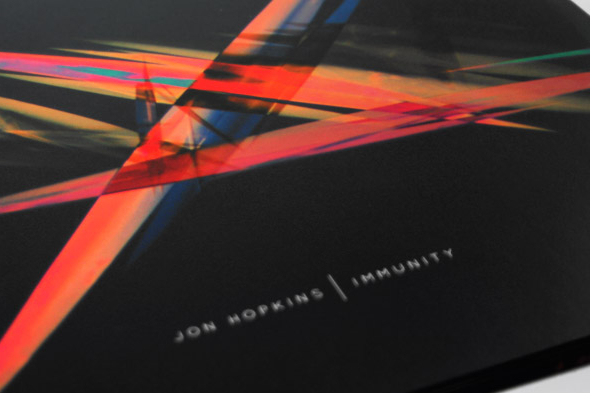
Album Twins: Hopkins / Kiasmos
I don’t know about you, but I tend to go through these phases with my music listening habits; maybe Krautrock or Morricone or even… Led Zeppelin (well, maybe not Led Zeppelin). When I’m into one of these periods, little else is going to satisfy my mood or hold my attention. I’ll need a full week or two of Cluster or whatever my current obsession is. And this goes for more than just my musical habits.
Sometimes the universe helps by creating two albums that seem destined to hang together. I call them Album Twins or Twin Albums, but let’s not worry about the nomenclature. Album twins are seemingly independent releases that enhance or expand upon the other. The Rolling Stones‘ Some Girls / Emotional Rescue and Iggy Pop’s The Idiot / Lust for Life are obvious examples in my opinion. I can’t hear one without thinking of the other.
Sometimes the relationship is more personal- for example, somewhere in my adolescent brain I related David Bowies’ Scary Monsters with Alice Cooper’s Flush the Fashion. Released in 1980, both album were viewed as more radio-friendly then the artists’ previous albums. In Bowie’s case, this was the trio of albums commonly know as the Berlin Trilogy. Superficially, the sleeve art has a vaguely similar shade and Cooper’s Flush is one of his more musically adventurous releases. I understand that both albums were fueled by the massive use of cocaine in the studio.
Jon Hopkin‘s minimalist techno masterpiece, Immunity (2013), and Kaismos’ 2014 release are a reflection of this unique musical synchronicity. Both albums are flush with the mechanical and futuristic beats of techno with a human warmth and intelligence that is unique in electronic music. In this particular case, Kiasmos is the musical younger brother of Hopkin’s landmark electroinc release.
The music is powerfully minimal; speaking, at times, amazingly soft and gentle. You need to listen very closely to discover Immunity’s many hidden passages. As a unifying concept, Hopkins captures a one-hour journey through a night out clubbing. Even using the sound of a car-door and keys on the first track to illustrate the excitement and possibilities the night has to offer. The idea works brilliantly.
However, Hopkins is much too smart then to just give us the standard beats and cliches of dance music. Instead, Immunity targets the rare territory between minimalist, avant-garde and classic techno. Along the way, he created a new step in electronic music; sensual and organically polished music that unfolds with a delicate beauty. And that masterpiece was without peer, or in this case sibling, for about one year.
Kiasmos’ 2014 self-titled release operates with much of the same energy and structure used by Hopkins. That is electronically manufactured music that pulsates with energy and, more importantly, is highly innovative and adventurous. Kiasmos uses the hallmarks of Immunity, but pushes the boundaries of structure and form. Each motif rolls out with the endless possibilities of light and shade until they eventually evaporate into the next idea. This is the rare techno that is both highly cerebral and emotional. The atmosphere is rich with these extraordinary liquid melodies that move like scented incense smoke, slowly twisting around a lone blue light in the back of your mind.
Like Hopkin’s 2013 classic, the beats on Kiasmoss are abstract and stay clear of the usual beats common to techno music. The multiple textures of sound blossom, but do so gently and melodically. Heavily influenced by the German Kompakt label, that specializes in Microhouse and minimal techno.
Together, Immunity and Kiasmos make for a deeply personal listening experience. Both albums leave conscious and thinking listeners- instead of a blissful drug haze, the feeling is reflective, alive and melancholic. This is delicate and vivid music that speaks with a new and unique voice. I leave you with only this warning: if you falling under the spell of these beautiful records, (almost) nothing else is going to satisfy when you are done. Best to start with side one.
by Shawn Ciavattone

[…] https://vinylwriters.com/album-twins-hopkins-kiasmos/But great music is full of surprises, and creativity is not the whim of a overly opinionated music critic. Singularity is Jon Hopkins’ 2018 follow up record to his minimalist techno classic Immunity (2013). Did I call Immunity a classic? […]
Awesome post, thanks for sharing!
Interesting review again, Shawn. Kiasmos is new for me but I will definitely check it. This spring I have listened quite a lot Jon Hopkins music and I waited so much his concert hall tour, which is now postponed to November. It’s amazing how he can hide so many details and layers into his minimal compositions. Album Twins is great idea!
Thank you. Jon Hopkins has one of the best discographies in electronic music. He’s a serious musician who is changing music in a positive way. Kiasmos is near perfect for anyone who appreciates his work.
The track “Immunity” is heartbreakingly beautiful, gorgeous instrumentation. It feels like a meaningful friendship that is slowly dissolving and coming to an inevitable end. The first tracks of “Kiasmos” carve a very similar feeling. I´m a huge fan of artists/bands that combine minimal techno with ambient, drone, acid house and avant-garde. I´ve found extreme pleasure in records like Four Tet´s “Rounds”,
Tim Hecker´s “Virgins” or BOC´s “Music has The Right To Children”.
Thank you for these recommendations, Shawn. There´s nothing to complain about their symbiotic relationship, you can notice the similarities immediately. Nevertheless, I´m going to experience these albums from start to finish.
The “Album Twins” is a great idea for a future series. Undoubtedly, there are so many records that share very similar feelings and atmospheres…
Interesting how often albums relate to each other. Sometimes the connection is complete and musical. But I the idea of albums that are very different that have a personal connection. But I think you’ll enjoy both these albums. Is the best of what modern electronic music has to offer. Thank you, Octavio.
Great jams!
Thank you for the comments.
Shawn,
Your vivid visual description of the Kiasmos music as an atmosphere “rich with these extraordinary liquid melodies that move like scented incense smoke, slowly twisting around a lone blue light in the back of your mind” definitely intrigues me. I’ve heard of Jon Hopkins before but I’ve not yet listened to Immunity. Your review makes me eager to explore these.
Also–I think the idea of starting a series on Vinyl Writers about Album Twins would be engaging. I’m curious to see more of your picks, Saliha’s, Octavio’s, and our other authors. I’d be interested in contributing to this series.
These are two great albums that will soon become favorites, I’m sure. Electronic music influenced by the melodic Cologne electronic scene is my absolute favorite. The twin-album idea could be a good one. Let’s see what comes out of it. Thank you, Mark.
These are both great records. Listening to them both as I work today. Hopkins is the masterpiece reaobring together all the elements together on one record. Yet, Kiasmos hold up really well. It’s a word the companion piece The name is immunity is strange given the context of our time.
Kiasmos is a great record, but I can only recommend it on cd, because the vinyl pressing is desastrous. The scraping noise of the needle can be clearly heard in quiet sequences. The vinyl is cracking and crackling, which would be ok if the record was already 20 years old and if I had bought it for 5 euros at a fleamarket. However, this is unacceptable for a new and sealed vinyl. Especially when press residues trickle out of the case and when there is dust on the panes before the first application listen.
No complaints with the Jon Hopkins record, which is also great.
Thank you for your comment. I gotta say, I must have got luck. My vinyl sound clean, flat and quiet. But CDs are a sure bet for music that requires a silent background. Maybe a different pressing? No argument about the music. Some of the best electronic music created. Melodic and beautiful.
Other twin artists : FSOL, Akira Yamaoka, Brian Reitzell, Amon Tobin.
A great album by Jon Hopkins – here and there somewhat mood-dependent, and sometimes a tough test for the nerves. But there is something for everyone who likes interesting, different electronic music. I’ll have to give Kiasmos a listen. Interesting idea to do album twins!
I think you’ll find Kiasmos is a great companion piece to Immunity. For me, it only lacks the conceptual design The Hopkins masterpiece. Thank you for your comments.